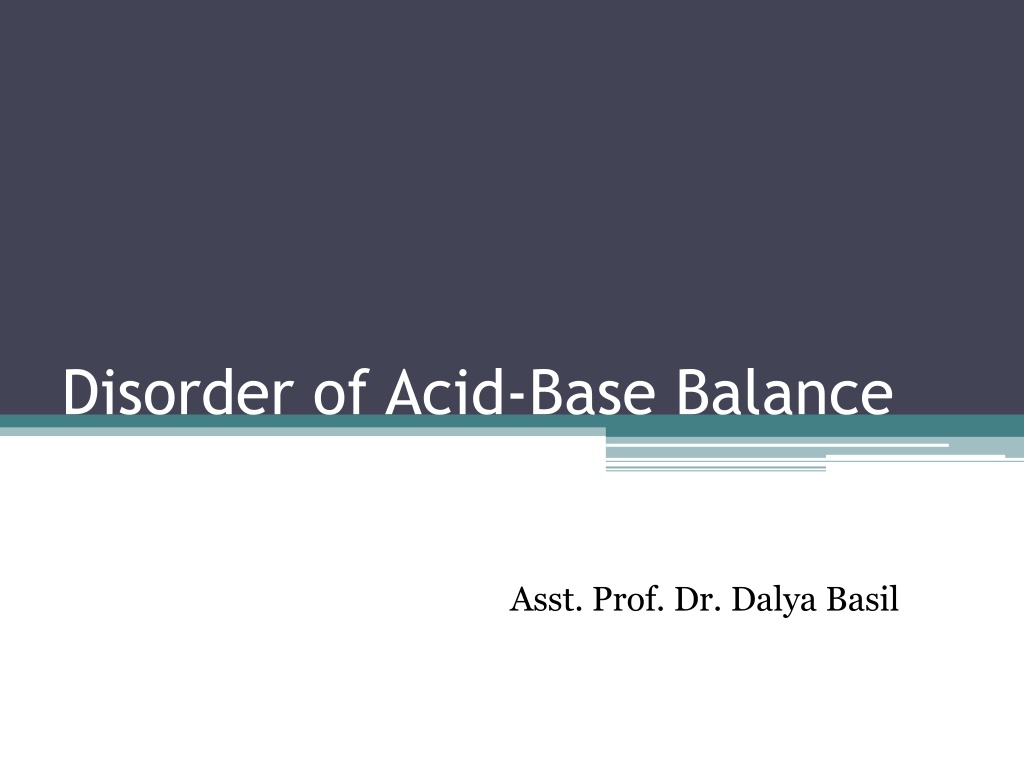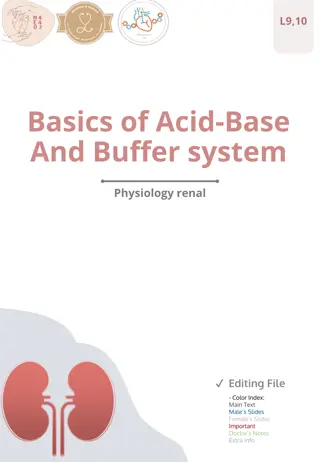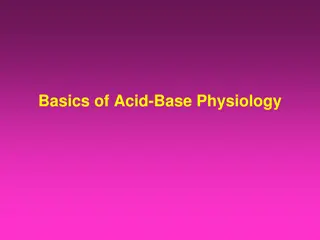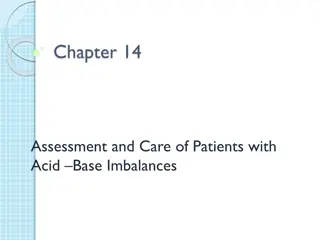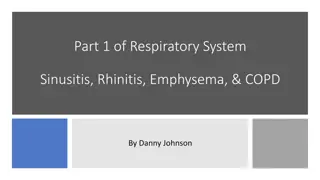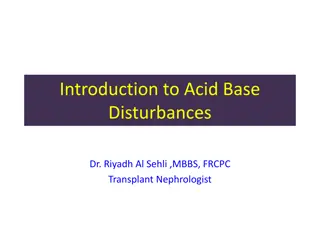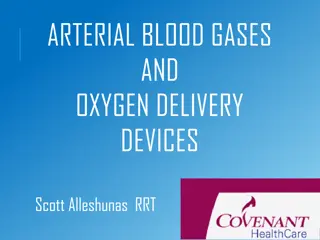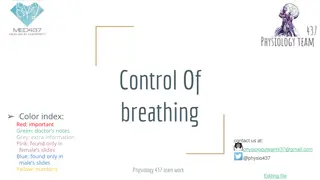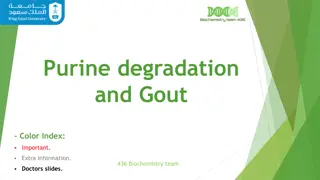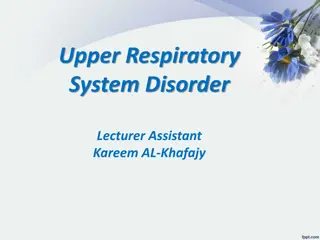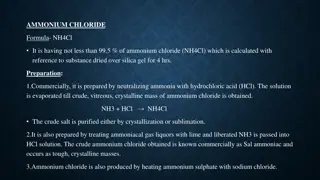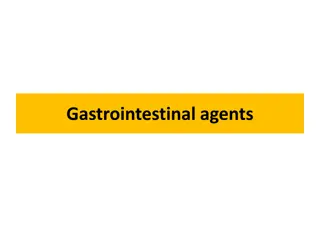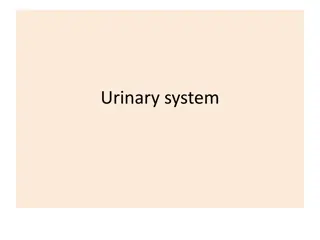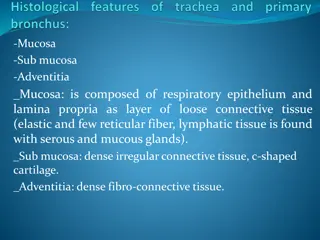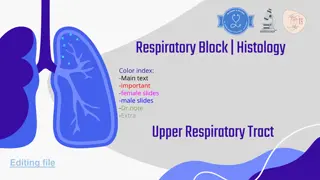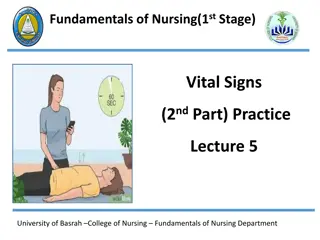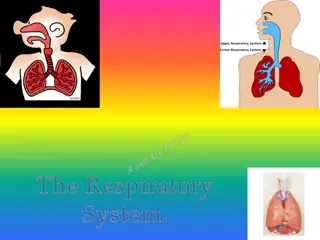Understanding Acid-Base Balance Disorders: Respiratory Acidosis Overview
Acid-base balance disorders manifest as metabolic and respiratory imbalances with distinct characteristics. Respiratory acidosis, a common condition, stems from impaired alveolar ventilation, leading to elevated CO2 levels and decreased pH. It can be acute or chronic, each presenting unique features that affect arterial CO2, serum HCO3, and pH levels. Compensation mechanisms play a crucial role in maintaining pH homeostasis under various pathophysiological conditions.
Download Presentation

Please find below an Image/Link to download the presentation.
The content on the website is provided AS IS for your information and personal use only. It may not be sold, licensed, or shared on other websites without obtaining consent from the author. Download presentation by click this link. If you encounter any issues during the download, it is possible that the publisher has removed the file from their server.
E N D
Presentation Transcript
Disorder of Acid-Base Balance Asst. Prof. Dr. Dalya Basil
Disorders of Acid-Base Balance There are two types of acid-base disorders: metabolic and respiratory. Respiratory disorders involve an alteration in the PCO2, reflecting an increase or decrease in alveolar ventilation. Respiratory acidosis is characterized by a decrease in pH, reflecting a decrease in ventilation and an increase in PCO2. Respiratory alkalosis involves an increase in pH, resulting from an increase in alveolar ventilation and a decrease in PCO2.
Disorders of Acid-Base Balance Acidosis and alkalosis typically involve a primary or initiating event and a compensatory or adaptive state that results from homeostatic mechanisms that attempt to correct or prevent large changes in pH. For example, a person may have a primary metabolic acidosis as a result of overproduction of ketoacids and respiratory alkalosis because of a compensatory increase in ventilation.
Primary Versus Compensatory Changes in pH Compensatory mechanisms provide a means to control pH when correction is impossible or cannot be immediately achieved. Compensation requires the use of mechanisms that are different from those that caused the primary disorder.
Primary Versus Compensatory Changes in pH For example, the lungs cannot compensate for respiratory acidosis that is caused by lung disease, nor can the kidneys compensate for metabolic acidosis that chronic kidney disease. The body can, however, use renal mechanisms to compensate for respiratory-induced changes in pH, and it can use respiratory mechanisms to compensate for metabolically induced changes in acid-base balance. occurs because of
Respiratory Acidosis Respiratory acidosis occurs in conditions that impair alveolar ventilation and cause an increase in serum PCO2, also known as hypercapnia, along with a decrease in pH. Respiratory acidosis can occur as an acute or chronic disorder. Acute respiratory failure is associated with a rapid rise in arterial PCO2 with a minimal increase in serum HCO3 and large decrease in pH. Chronic respiratory acidosis is characterized by a sustained increase in arterial PCO2, resulting in renal adaptation with a more marked increase in serum HCO3 and a lesser decrease in pH.
Respiratory Acidosis Acute respiratory acidosis can be caused by impaired function of the respiratory center in the medulla (as in narcotic overdose), lung disease, chest injury, weakness of the respiratory muscles, or airway obstruction. Almost all persons with acute respiratory acidosis are hypoxemic if they are breathing room air. In many cases, signs of hypoxemia develop prior to those of respiratory acidosis because CO2 diffuses across the alveolar capillary membrane 20 times more rapidly than oxygen.
Respiratory Acidosis Chronic respiratory acidosis is a relatively common disturbance in persons with chronic obstructive lung disease. In these persons, the persistent elevation of PCO2 stimulates renal H secretion and HCO3 effectiveness of these compensatory mechanisms can often return the pH to near-normal values as long as oxygen levels are maintained within a range that does not suppress chemoreceptor control of respirations. reabsorption. The
Manifestation of Respiratory Acidosis Respiratory acidosis is associated with a serum pH below 7.35 and an arterial PCO2 above 50 mm Hg. The signs and symptoms of respiratory acidosis depend on the rapidity of onset and whether the condition is acute or chronic. Because respiratory accompanied by hypoxemia, the manifestations of respiratory acidosis often are intermixed with those of oxygen deficit. acidosis often is
Respiratory Alkalosis Respiratory alkalosis is a systemic acid-base disorder characterized by a primary decrease in blood PCO2, also referred to as hypocapnia, which produces an elevation in pH and a subsequent decrease in HCO3.
Causes of Respiratory Alkalosis 1- hyperventilation or a respiratory rate in excess of that needed to maintain normal PCO2 levels. 2- It may occur as the result of central stimulation of the medullary respiratory center or stimulation of peripheral pathways to the medullary respiratory center. Respiratory alkalosis is caused by
Manifestation of Respiratory Alkaosis Respiratory alkalosis manifests with a decrease in PCO2 and a deficit in H2CO3. In respiratory alkalosis, the pH is above 7.45, arterial PCO2 is below 35 mm Hg, and serum HCO3 levels usually are below (24 mmol/L). The signs and symptoms of respiratory alkalosis are associated with hyperexcitability of the nervous system and a decrease in cerebral blood flow
Manifestation of Respiratory Alkaosis Alkalosis increases protein binding of extracellular calcium. This reduces ionized calcium levels, causing an increase in neuromuscular excitability. A decrease in the CO2 content of the blood causes constriction of cerebral blood vessels. Because CO2 crosses the blood-brain barrier manifestations of acute respiratory alkalosis are usually of sudden onset. experiences light-headedness, dizziness. These manifestations may be accompanied by sweating, palpitations, air hunger, and dyspnea. rather quickly, the The person often
